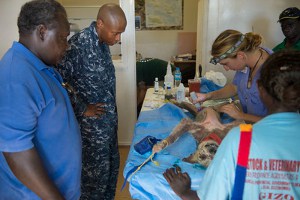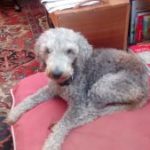
When you take your pup home after neutering surgery, it’s natural to be sick with worry.
The poor guy is still dazed, probably giving you the stink eye because it was you who took him to the vet, and, on top of that, the incision doesn’t look so good.
Or so you think. What can you do?
You need a crash course in post-surgery care to understand how long does it take for the wound to heal, what should it look like, what’s normal and what not, etc.
We’ve got answers for all your questions.
Just to put your mind at ease – if the incision is but slightly open and there’s a clear or pink discharge there’s no need for you to worry.
Relax, sit back and read on!
How does a dog behave straight after surgery?
Immediately after surgery your dog will be disoriented and not his usual self.
This has to do with the anaesthesia he received and its effects can last up to 24 hours.
On the other hand, there’s also the psychological trauma he’s been through.
The dog doesn’t know he’s been castrated, but all the commotion with going to the vet and being handled by strangers will leave him confused.
Another thing you need to consider is that he might be experiencing some pain and discomfort as the effects of the anti-pain medication administered during surgery start to wear off.
If the vet gave you some meds, administer them as directed and don’t try to give your dog human painkillers as they might be dangerous for your pet.
It is recommended that you offer your pet some water as soon as you get home, but only a little or else he might vomit.
After a few hours you should offer a small portion of food, roughly half of what he normally eats.
Don’t worry if he doesn’t have much of an appetite, this is normal. Just leave him be.
The next day he should be able to eat and drink normally.
How long should a neuter wound take to heal?
The time a neuter wound takes to heal depends on your dog’s age and size.
Puppies who are neutered very young, around the age of two months, need very little time to bounce back.
They’ll be back to their old selves by the next day and the wound will need just a few days to heal.
This is because the smaller a dog is, the smaller the incision will be, so there’s little to heal.
Generally speaking, a neutering incision should be fully healed within 10 – 14 days.
Large breed dogs mature later which is why sometimes vets postpone the neutering surgery until they’re one year old.
This means the incision will be larger, so it will take longer to heal.
Male dogs recover easier after neutering than females. Spaying involves the removal of internal organs, sometimes including the uterus so they have a hard time healing.
What should a properly healed wound look like?
Take a good look at the incision wound as soon as you get home. If the vet was OK with the way the wound looked when they sent you home, that’s how it should generally look while it heals.
Here’s what a wound that is healing properly should look like:
- The edges of the incision should be perfectly aligned, touching each other with no gaps
- The skin should be bright pink or just slightly reddish
- A small clear or pink discharge is OK
- Some bruising and swelling around the incision site is to be expected
- Small amount of blood leaking is OK, but it should stop after 24 hours
What are the signs that an incision isn’t healing properly?
Puppies should be monitored closely after neutering surgery and the vet probably told you to check the wound several times a day. This can be very stressful and it’s easy to worry yourself sick, especially if it’s your first puppy and you have zero experience with such things. Still, complications are rare after this type of surgery so there’s no need to panic.
Here’s are the signs that indicate there might be a problem with the wound:
- Skin going bright red at the incision site
- The wound and the surrounding area becomes hot to the touch
- Excessive blood or fluids dripping from the incision
- Puss or a yellowish discharge
- Foul smell
What should I do if the incision opens?
If the incision opens up just a bit that’s not an immediate cause for alarm. This may happen if the dog somehow manages to lick his wound or moves around too much.
A little blood seeping from the wound should not worry you, but monitor the dog closely to see if it stops. If the bleeding stops and there’s no further gaping, let the dog rest. You can take him to the vet the next day for a check up.
However, if the gap gets bigger and there’s a continuous trickle of blood coming out, you should take him to the vet right away. If the brightly-colored subcutaneous tissues become exposed or there’s an obvious swelling of the incision, that indicates something is clearly wrong. If necessary, take the dog to the emergency room.
How should I stop my dog from licking the wound?
As the anaesthetic wears off and the dog feels pain and discomfort at the incision site, he will try to lick it better. You’ll have to keep him under surveillance at all times as by licking the wound there’s the risk it might open or get infected.
The vet probably gave you an Elizabethan cone, aka the cone of shame, and the dog needs to wear it until the wound is properly healed. That’s easier said than done and some dogs will be very vocal about their displeasure. Ignore your dog’s protests as wearing an e-cone is for his own good.
Some pet owners worry the poor dog won’t be able to eat with that thing on. Actually, a dog can very well eat with a cone around his neck, but if you want to make it easier for him you can raise his food bowl on a small crate or something of the kind.
If you do take his cone off while he eats or when you take him out to go potty, don’t let him out of sight and keep him on a leash. Any attempt to lick at the wound should be promptly discouraged, with the command “Leave it”!
Put the collar back on as soon as he’s done eating.
What should I do if my dog can’t tolerate an e-collar?
Vets often insist that Elizabethan collars are the safest for a recovering dog, only pets simply hate it when they’re fitted with a lampshade over their neck. If you cannot stand seeing your pooch in distress, know there are options. You can find a great variety of inflatable collars which are softer and, most of all, don’t restrict the dog’s peripheral vision like the e-cone.
Try for instance a Kong cushion, which is light-weight and comfortable to wear. Also, it’s sturdy enough so the dog won’t be able to destroy it, unless, of course, he’s very determined.
You can also try a soft-cone, which looks pretty much the same as the cone of shame, only it’s not made of hard plastic. A Comfy Cone is soft and padded, and it allows the dog more freedom of movement.
These alternatives work great for more mellow dogs. A rambunctious dog will try to contort his body in ways you’d have thought impossible just to be able to lick that wound.
Another great alternative is a post-surgical dog suit which covers the wound area so the dog cannot lick it. A dog suit is like a onesie and it has caps on the back so there’s no risk of the dog accidentally ripping it open.
If you’re good with your hands you can repurpose an old T-shirt. You already have the holes for the upper legs and you can make two additional ones for the lower ones. The shirt can be fastened with safety pins or caps. These shirts are soft and easy to wear but the problem is that you can’t really keep an eye on the incision wound to see how its’ healing.
Should I exercise my dog?
Dogs recovering after neutering surgery don’t need any sort of exercise. On the contrary, you should make sure the dog rests a lot and doesn’t make any energetic moves that might cause the wound to open up.
It is recommended that you isolate the dog from other pets in the house and you don’t allow him to play or jump. If there’s a staircase in your house, barricade it so your pet doesn’t go up and down.
If necessary, crate the dog, but see to it that he’s as comfortable as possible. In addition to food and water, give him his favorite toys. This would be the right moment to present him with a new toy, preferably some sort of puzzle to distract his mind from the annoying suture he cannot reach.
Also, do not allow your dog to rub his belly against rough surfaces as this might cause the wound to open up again or get infected.
Should I clean the wound and if so, how?
Dogs who have their neutering surgery should not be bathed for at least one week. Also, you should see to it that the wound doesn’t get wet, like if it rains outside.
A wound healing properly doesn’t need to be cleaned. However, if, despite your best efforts, the wound appears to be dirty, clean it with cotton balls or pads and plain warm water. Don’t try to dislodge blood crust as this might make the bleeding start again.
Don’t ever use alcohol or hydrogen peroxide on the incision. Use beta-dine instead as it is a very strong disinfectant and doesn’t sting.
Always dab the antiseptic instead or rubbing at the wound.
Closing Thoughts
When you schedule your dog’s neutering surgery make sure there’s going to be someone to keep an eye on him 24/7, at least for the first few days. You need to make sure your dog doesn’t get to lick the wound, as this can cause it to open.
Don’t be alarmed if there appears to be a small gap in the wound. Keep monitoring it over the following hours. If there’s no bleeding or puss, you can safely wait till the next day to see the vet if you’re still concerned by that time.
However, wounds that start to open more and more, swell up, get bright red and hot are a cause for alarm. Head to the vet straight away.
The first few days after neutering a dog will need lots of rest, no physical exertion and lots of love and affection.





